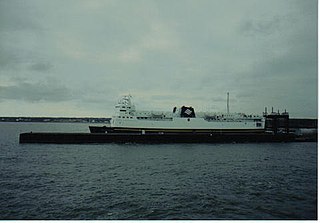
The Canadian National Railway Company is a Canadian Class I freight railway headquartered in Montreal, Quebec, which serves Canada and the Midwestern and Southern United States.

The Intercolonial Railway of Canada, also referred to as the Intercolonial Railway (ICR), was a historic Canadian railway that operated from 1872 to 1918, when it became part of Canadian National Railways. As the railway was also completely owned and controlled by the Government of Canada, the Intercolonial was also one of Canada's first Crown corporations.

Marine Atlantic Inc. is an independent Canadian federal Crown corporation which is mandated to operate ferry services between the provinces of Newfoundland and Labrador and Nova Scotia.

The Prince Edward Island Railway (PEIR) was a historic Canadian railway in Prince Edward Island (PEI). The railway ran tip-to-tip on the island, from Tignish in the west to Elmira in the east, with major spurs serving Borden-Carleton's train ferry dock, the capital in Charlottetown, Montague and Georgetown and the original eastern terminus at Souris. A major spur from Charlottetown served Murray Harbour on the south coast.

Channel-Port aux Basques is a town at the extreme southwestern tip of Newfoundland fronting on the western end of the Cabot Strait. A Marine Atlantic ferry terminal is located in the town which is the primary entry point onto the island of Newfoundland and the western terminus of the Newfoundland and Labrador Route 1 in the province. The town was incorporated in 1945 and its population in the 2021 census was 3,547.

CN Marine was a Canadian ferry company headquartered in Moncton, New Brunswick.

The Newfoundland Railway was a narrow-gauge railway that operated on the island of Newfoundland from 1898 to 1988. With a total track length of 906 miles (1,458 km), it was the longest 3 ft 6 in narrow-gauge system in North America.
Terra Transport (TT) was the name for the Newfoundland Transportation Division, a wholly owned subsidiary of Canadian National Railway (CN), created in 1979 as a means to organize the company's operations on Newfoundland.
The Canadian Northern Pacific Railway (CNoPR) was an historic Canadian railway with a main line running between the Alberta–British Columbia border and Vancouver, British Columbia. It was a wholly owned subsidiary of the Canadian Northern Railway (CNoR). This railway existed mainly on paper, and there were no cars or locomotives lettered "Canadian Northern Pacific". As far as the public and most workers were concerned, it was just a part of the CNoR.

The Ocean, previously known as the Ocean Limited, is a passenger train operated by Via Rail in Canada between Montreal, Quebec, and Halifax, Nova Scotia. It is the oldest continuously operated named passenger train in North America. The Ocean's schedule takes approximately 22 hours, running overnight in both directions. Together with The Canadian and Via's corridor trains, the Ocean provides a transcontinental service across Canada.

M/V William Carson was a CN Marine passenger/vehicle icebreaker ferry named in honour of Newfoundland colonial politician William Carson.

MV Joseph and Clara Smallwood was a Marine Atlantic passenger/vehicle ferry which operated between Newfoundland and Cape Breton Island in eastern Canada. She is named after former Newfoundland premier Joseph R. Smallwood and his wife Clara.

MV Caribou was a Marine Atlantic passenger/vehicle ferry which operated between the islands of Newfoundland and Cape Breton in eastern Canada.

MV John Hamilton Gray was an icebreaking railway, vehicle, and passenger ferry which operated across the Abegweit Passage of Northumberland Strait, connecting Port Borden to Cape Tormentine between 1968–1997.

SS Caribou was a Newfoundland Railway passenger ferry that ran between Port aux Basques, in the Dominion of Newfoundland, and North Sydney, Nova Scotia between 1928 and 1942. During the Battle of the St. Lawrence the ferry participated in thrice-weekly convoys between Nova Scotia and Newfoundland. A German submarine attacked the convoy on 14 October 1942 and Caribou was sunk. She had women and children on board, and many of them were among the 137 who died. Her sinking, and large death toll, made it clear that the war had really arrived on Canada's and Newfoundland's home front. Her sinking is cited by many historians as the most significant sinking in Canadian-controlled waters during the Second World War.
Route 1 is a highway in the Canada province of Newfoundland and Labrador, and is the easternmost stretch of the Trans-Canada Highway. Route 1 is the primary east–west road on the island of Newfoundland.

Although most railways of central and eastern Canada were initially built to a 5 ft 6 in broad gauge, there were several, especially in Atlantic Canada and Ontario, which were built as individual narrow-gauge lines. These were generally less expensive to build, but were more vulnerable to frost heaving because vertical displacement of one rail caused greater angular deflection of the narrower two-rail running surface. Most of the longer examples were regauged starting in the 1880s as the railway network began to be bought up by larger companies.

The Hillsborough River Bridge is a bridge crossing the Hillsborough River estuary between Charlottetown and Stratford in Queens County, Prince Edward Island. The current road bridge, built in 1962, replaced a 1905 rail bridge crossing the same span which was known by the same name.

MV Patrick Morris was a train ferry regulated by the Canadian National Railway (CN) that sank on her run from North Sydney, Nova Scotia to Port aux Basques, Newfoundland during a storm in the early morning of 20 April 1970 while responding to a mayday call from the Newfoundland-based herring seiner FV Enterprise. The ship's Captain Roland Penney was given permission to leave North Sydney ahead of schedule to assist the distressed wood-hulled fishing vessel .No passengers were aboard Patrick Morris when she set sail shortly before midnight for the rescue mission on 19 April.
















